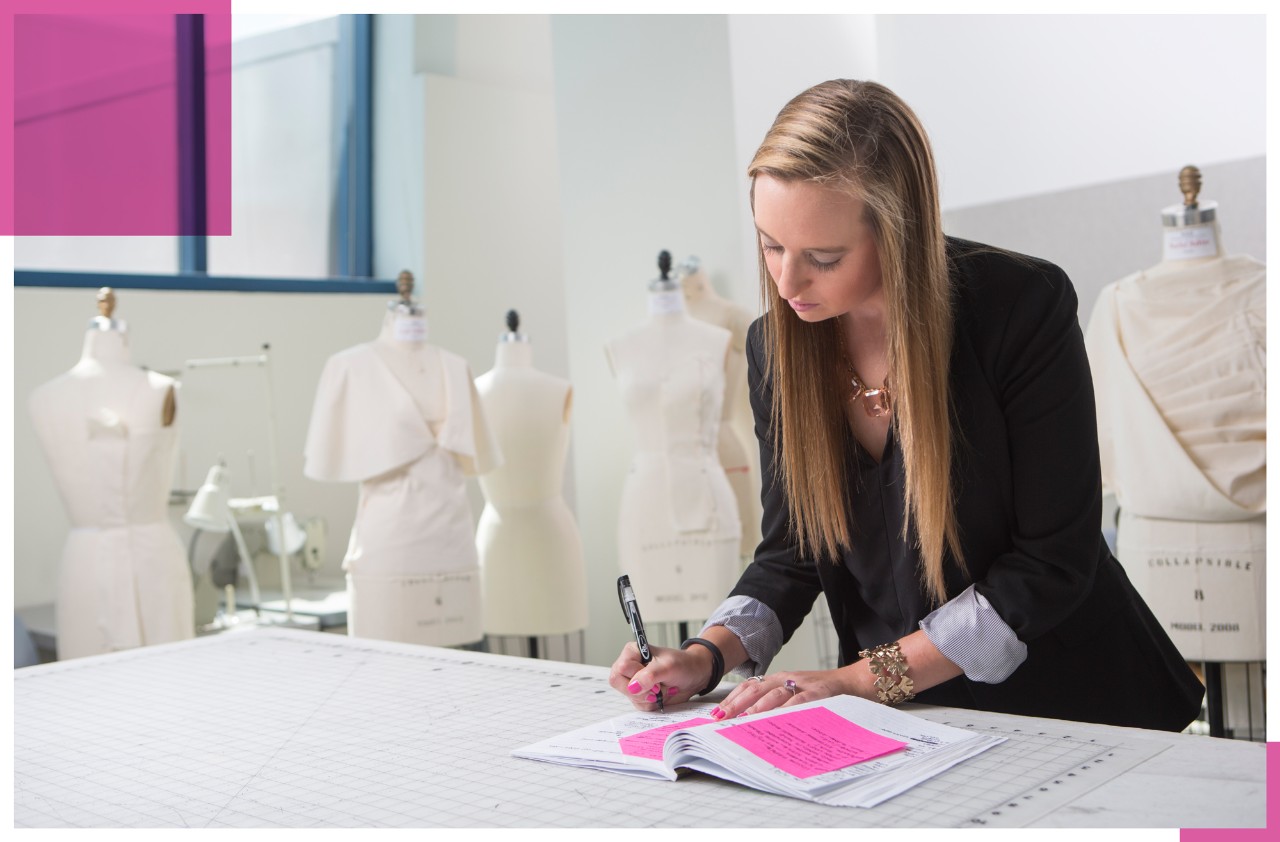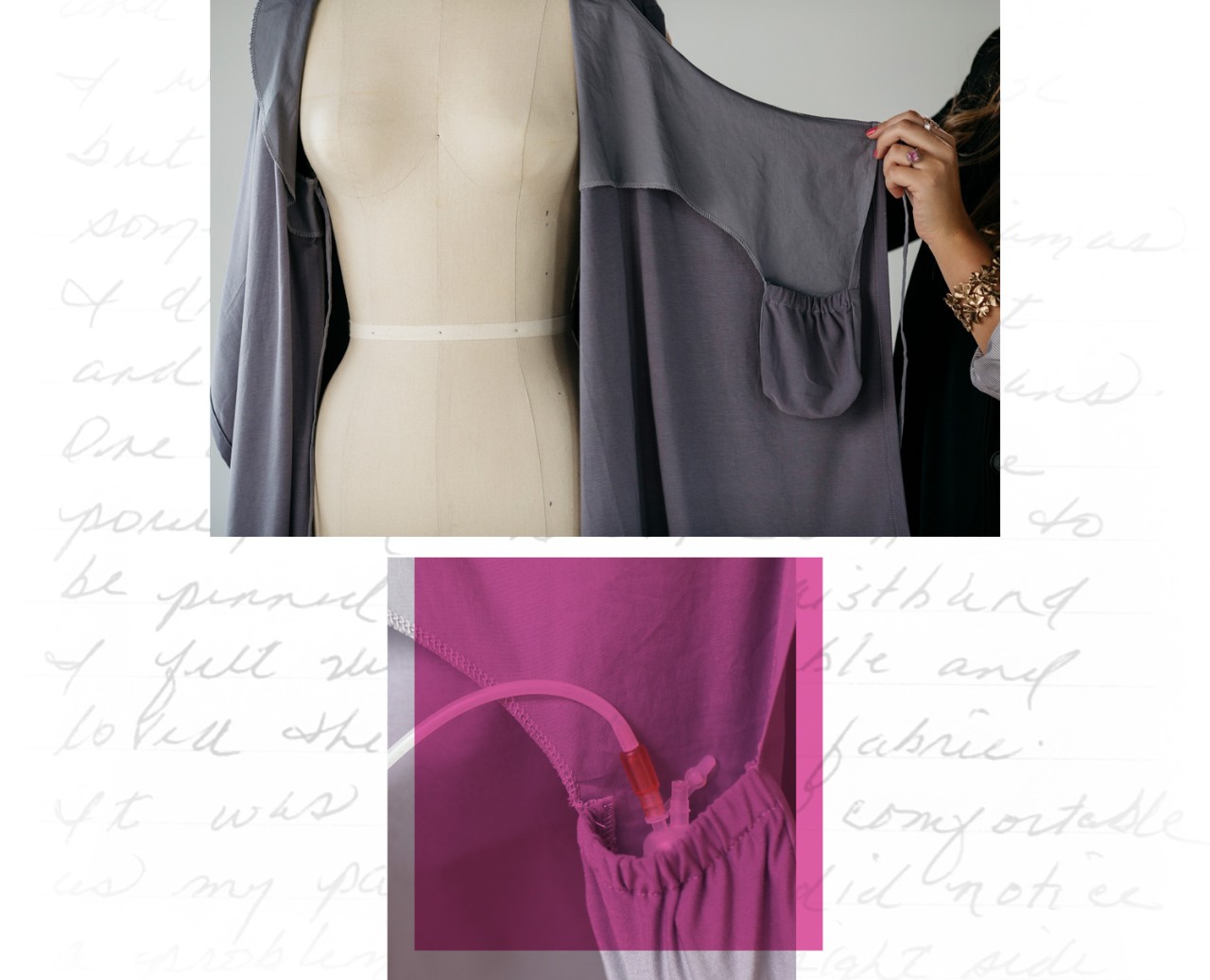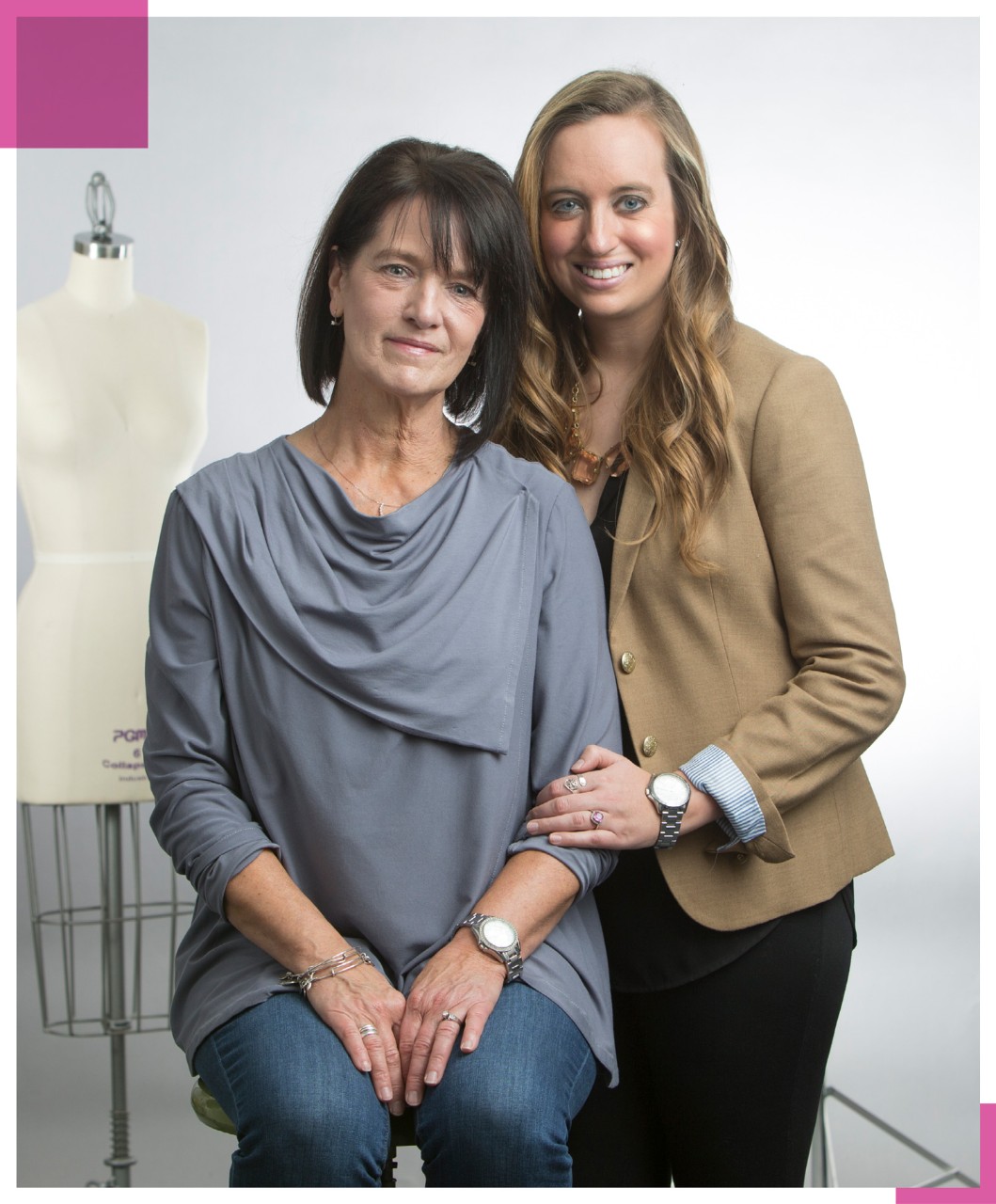UC graduate Megan Sullivan adjusts the garment worn by her mother, Ann Sullivan. Megan’s clothing line, With Grace B. Bold, was inspired by Ann’s battle with breast cancer.
UC graduate Megan Sullivan adjusts the garment worn by her mother, Ann Sullivan. Megan’s clothing line, With Grace B. Bold, was inspired by Ann’s battle with breast cancer.

hen Megan Sullivan was 9 years old, she didn’t know much about what her mother was enduring.
All she knew was that her then-42-year-old mother, Ann, had breast cancer, lost her hair and wore a wig. Ann had done her best to conceal the more frightening details of her ordeal.
It was only in adulthood that the University of Cincinnati alumna learned the details she didn’t know about as a child: the nine rounds of chemotherapy, the stage 3 breast cancer’s progression to Ann’s lymph nodes, the radiation treatments or the partial mastectomy that resulted in far more tissue being removed than anticipated. And she didn’t know about the surgical drains — plastic tubes attached to collection bulbs — that were siphoning blood-like fluid away from the incisions, hidden under a bathrobe.
Sullivan, DAAP ’15, M (DAAP) ’16, has dedicated the past four years of her life to helping women with breast cancer maintain their dignity and freedom, particularly those who are recovering from surgery. Both her undergraduate capstone project and her master’s thesis in fashion design at UC’s College of Design, Architecture, Art, and Planning focused on devising clothing that gives women a fashionable way to conceal drainage tubing and fluid collection bulbs.

Sullivan’s clothing line, With Grace B. Bold, launched a Kickstarter crowdfunding campaign Oct. 1, 2017, coinciding with the beginning of Breast Cancer Awareness Month. Fewer than 36 percent of all Kickstarter campaigns get fully funded, but With Grace B. Bold beat those odds with a last-minute push across the $35,000 finish line. Sullivan, 25, is now hard at work to achieve her goal of shipping first garments by end of June.
“My mission is to help as many women as I can affected by breast cancer,” she wrote to her campaign’s supporters after its successful conclusion, “and now, with all of your support, I’m going to be able to help hundreds of women feel beautiful, confident and boldly sophisticated. This is all because of you. Thank you, from the bottom of my heart!”
When she was a third-year fashion design student at DAAP, Sullivan found inspiration in her past — her mother’s battle with and recovery from breast cancer. When Sullivan asked her mom about what the worst part of that experience was, she was surprised by the answer she got. It wasn’t the chemo, the surgery or the radiation. It was the surgical drain.
“The thing that is so bothersome about it is that it’s so cumbersome,” Ann recalls. “We had to wind it up and figure out a place to attach it to my bathrobe. And clothing? There just weren’t that many options out there at that time. The whole experience is unnerving anyway, and then to have this piece of medical equipment attached to you — they didn’t warn me about that when I had the surgery.”
Sullivan began thinking about what it would be like to be in that predicament. She imagined having surgical drains attached while going out to a show, while returning to work, while running errands. “As a young woman coming into my own womanhood and knowing how I’d feel if I was in that position, I can’t even put into words the effect that has on me,” she says. “It’s every emotion — it’s anger and sadness and a fiery drive to fix this problem.”
It's every emotion — it's anger and sadness and a fiery drive to fix the problem.
–Megan Sullivan, DAAP alumna

Megan Sullivan plans to begin with two core designs when her company launches, but she has sketched ideas for many more.
Sullivan dedicated the next four years to creating a clothing line that would give women (especially those whose recovery included surgical drains) a sharp, luxurious garment that they’d be proud to wear in public. She worked through sketch after sketch, iteration after iteration, to create her prototype. Feature by feature, her first garment started to come together.
For her master’s thesis, Sullivan worked with the UC Health Barrett Cancer Center to create a testing protocol. Women who agreed to participate wore Sullivan’s garments home from the hospital and then wrote in journals about how the garment felt, how the drain fit and how it made them feel. This feedback informed new iterations of Sullivan’s creation.
“I was absolutely overwhelmed at her ability to have that insight and compassion for what women go through,” says Ann. “She was spot on. She couldn’t have done better.”
I was absolutely overwhelmed at her ability to have that insight and compassion for what women go through.
–Ann Sullivan, Megan's mother

A hidden pocket is designed to conceal a surgical drain.
The result: A thoughtfully designed, fashionable top that addresses the obstacles women recovering from breast surgery commonly face. Because they can’t lift their arms above their head during recovery, the garment wraps around and is tied together on the inside and fastened on the outside with two snaps at the shoulder. A system of stabilizers hold the tubing in place, and pockets inside the garment are perfectly contoured to fit the drainage bulb. The soft, bamboo-knit fabric — all natural to prevent irritation to healing incisions — drapes to conceal the form of the drains, and the full neckline includes fabric that puddles and adds volume to the chest.
“Products like these are truly appreciated and adored by our patients,” says Elyse Lower, professor in the UC College of Medicine, director of the UC Cancer Institute’s Comprehensive Breast Cancer Center and a UC Health oncologist. “When you add functionality into a stylish item like this, it’s just icing on the cake. It improves overall morale and the ability for a patient to feel more like themselves in a tough situation. When you look good, you just feel better.”
Sullivan named her first garment the Ann Elizabeth in honor of her mother and plans to name other garments in the line after other breast cancer survivors who have inspired her. The clothing line’s name honors both her mother and the late Hanna Hall, the UC fashion design and product development professor Sullivan worked with on her thesis. Hall and Sullivan had decided that this line of clothing would allow women to boldly reclaim their confidence and self-esteem during a time when both are likely suffering.

The relationship between Ann and Megan Sullivan has always been close, but Megan gained a deeper understanding of her mother’s struggle with cancer while working on the clothing line it inspired.
When Sullivan first began working on the With Grace B. Bold clothing line, she didn’t see it as a business opportunity. It was a labor of love for her, a way to honor her mother and others who had inspired her. At first she bristled at the idea of making money from it, but she eventually became convinced that this was a way for her to dedicate her life to helping others.
“I was at this point where I had been working on this for a really long time,” Sullivan recalls. “I had really solid prototypes. I had the testimonials. It was just a question of how to take this and launch a business out of this.
How do I start a company? And that was kind of a tough thing for me to get my head around.”
A meeting with Tom Dalziel, the executive director of the Carl H. Lindner College of Business’ Center for Entrepreneurship and Commercialization, was the first in a series of events that eventually led to Sullivan’s brand being named a finalist for funding from the Fealy Bearcat Bridge Fund. That opened the door for Sullivan to participate in the StartupUC Incubator program, where she met her mentors, Piola Shoes founder Josh Rudd, Bus ’12, and Dick Baker, a former Procter & Gamble executive and the chairman of the Cincinnati SCORE Association.
“With their help, I worked on formulating cash flows and thinking about seed money and funding,” says Sullivan. “I went to investing seminars and basically did this year of intensive research on how to start a company.”
Sullivan has demonstrated her commitment to approaching the business with a philanthropic mindset. She plans to offer two different give-back programs. Sullivan recognizes that not all women who use the Ann Elizabeth top during their recoveries will want to keep the garment afterward because of its connection to the experience, so she plans to offer shipping labels to women who want to donate their clothing to hospitals. She also plans to offer the option for anyone to purchase garments and donate them directly to hospitals to be given to women without the financial means to afford them.
Because of her innovative design, Sullivan helps women — who struggle just like her mother did — navigate a difficult journey with dignity and, perhaps, some style.
LINK:

Matt Koesters is a public information officer at the University of Cincinnati and contributes to UC Magazine.
Additional Credits: Thanks to photographer Andrew Higley, designer Michelle Ensch as well as web developers Kerry Overstake and Carolyn Noe for helping to develop and present the content contained in this piece.
Inspired by her mother, DAAP alumna launches clothing line for women recovering from breast surgery.
The 1991 implosion of UC’s Sander Hall continues to reverberate with the upcoming release of a powerful new book about the building’s architect from the perspective of his daughter.
Matt Berninger and Scott Devendorf of alt-rock band The National reflect on their formative years at UC.
UC’s new high school ambassador program could serve as a national model for helping low-income and first-generation students attend college.
How a local man gained precious time with his family thanks to innovative UC cancer treatment.
Leading urban public universities into a new era of innovation and impact.